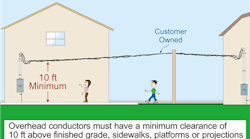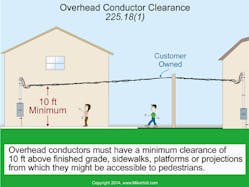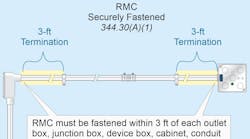Q. When installing outside branch circuits and feeders, what is the minimum vertical clearance required for overhead conductors?
Find the Answer
Overhead conductor spans must maintain vertical clearances as follows [225.18]:
- 10 ft above finished grade, sidewalks, platforms, or projections from which they might be accessible to pedestrians for 120V, 120/208V, 120/240V, or 240V circuits (Figure).
- 12 ft above residential property and driveways, and those commercial areas not subject to truck traffic for 120V, 120/208V, 120/240V, 240V, 277V, 277/480V, or 480V circuits.
- 18 ft over public streets, alleys, roads, parking areas subject to truck traffic, driveways on other than residential property, and other areas traversed by vehicles (such as those used for cultivation, grazing, forestry, and orchards).
- 24½ ft over track rails of railroads.
Overhead conductors located above pools, outdoor spas, outdoor hot tubs, diving structures, observation stands, towers, or platforms must be installed in accordance with the clearance requirements in Sec. 680.8.





